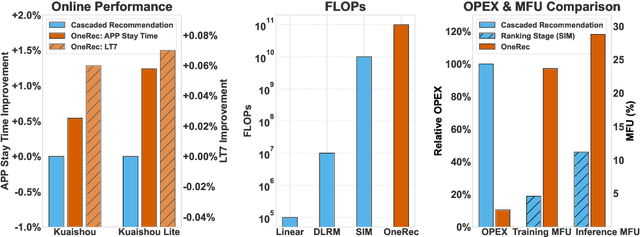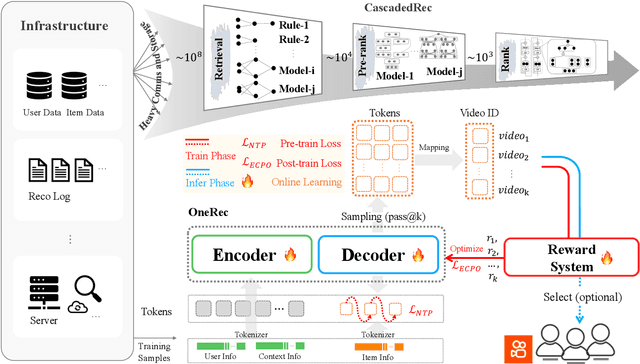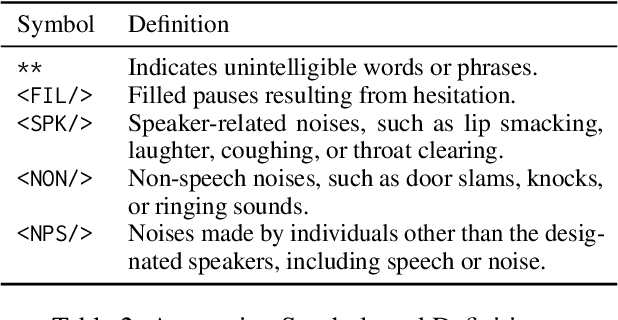Shiyao Wang
OneRec-V2 Technical Report
Aug 28, 2025Abstract:Recent breakthroughs in generative AI have transformed recommender systems through end-to-end generation. OneRec reformulates recommendation as an autoregressive generation task, achieving high Model FLOPs Utilization. While OneRec-V1 has shown significant empirical success in real-world deployment, two critical challenges hinder its scalability and performance: (1) inefficient computational allocation where 97.66% of resources are consumed by sequence encoding rather than generation, and (2) limitations in reinforcement learning relying solely on reward models. To address these challenges, we propose OneRec-V2, featuring: (1) Lazy Decoder-Only Architecture: Eliminates encoder bottlenecks, reducing total computation by 94% and training resources by 90%, enabling successful scaling to 8B parameters. (2) Preference Alignment with Real-World User Interactions: Incorporates Duration-Aware Reward Shaping and Adaptive Ratio Clipping to better align with user preferences using real-world feedback. Extensive A/B tests on Kuaishou demonstrate OneRec-V2's effectiveness, improving App Stay Time by 0.467%/0.741% while balancing multi-objective recommendations. This work advances generative recommendation scalability and alignment with real-world feedback, representing a step forward in the development of end-to-end recommender systems.
MISS: Multi-Modal Tree Indexing and Searching with Lifelong Sequential Behavior for Retrieval Recommendation
Aug 20, 2025



Abstract:Large-scale industrial recommendation systems typically employ a two-stage paradigm of retrieval and ranking to handle huge amounts of information. Recent research focuses on improving the performance of retrieval model. A promising way is to introduce extensive information about users and items. On one hand, lifelong sequential behavior is valuable. Existing lifelong behavior modeling methods in ranking stage focus on the interaction of lifelong behavior and candidate items from retrieval stage. In retrieval stage, it is difficult to utilize lifelong behavior because of a large corpus of candidate items. On the other hand, existing retrieval methods mostly relay on interaction information, potentially disregarding valuable multi-modal information. To solve these problems, we represent the pioneering exploration of leveraging multi-modal information and lifelong sequence model within the advanced tree-based retrieval model. We propose Multi-modal Indexing and Searching with lifelong Sequence (MISS), which contains a multi-modal index tree and a multi-modal lifelong sequence modeling module. Specifically, for better index structure, we propose multi-modal index tree, which is built using the multi-modal embedding to precisely represent item similarity. To precisely capture diverse user interests in user lifelong sequence, we propose collaborative general search unit (Co-GSU) and multi-modal general search unit (MM-GSU) for multi-perspective interests searching.
Kwai Keye-VL Technical Report
Jul 02, 2025Abstract:While Multimodal Large Language Models (MLLMs) demonstrate remarkable capabilities on static images, they often fall short in comprehending dynamic, information-dense short-form videos, a dominant medium in today's digital landscape. To bridge this gap, we introduce \textbf{Kwai Keye-VL}, an 8-billion-parameter multimodal foundation model engineered for leading-edge performance in short-video understanding while maintaining robust general-purpose vision-language abilities. The development of Keye-VL rests on two core pillars: a massive, high-quality dataset exceeding 600 billion tokens with a strong emphasis on video, and an innovative training recipe. This recipe features a four-stage pre-training process for solid vision-language alignment, followed by a meticulous two-phase post-training process. The first post-training stage enhances foundational capabilities like instruction following, while the second phase focuses on stimulating advanced reasoning. In this second phase, a key innovation is our five-mode ``cold-start'' data mixture, which includes ``thinking'', ``non-thinking'', ``auto-think'', ``think with image'', and high-quality video data. This mixture teaches the model to decide when and how to reason. Subsequent reinforcement learning (RL) and alignment steps further enhance these reasoning capabilities and correct abnormal model behaviors, such as repetitive outputs. To validate our approach, we conduct extensive evaluations, showing that Keye-VL achieves state-of-the-art results on public video benchmarks and remains highly competitive on general image-based tasks (Figure 1). Furthermore, we develop and release the \textbf{KC-MMBench}, a new benchmark tailored for real-world short-video scenarios, where Keye-VL shows a significant advantage.
Kling-Foley: Multimodal Diffusion Transformer for High-Quality Video-to-Audio Generation
Jun 24, 2025Abstract:We propose Kling-Foley, a large-scale multimodal Video-to-Audio generation model that synthesizes high-quality audio synchronized with video content. In Kling-Foley, we introduce multimodal diffusion transformers to model the interactions between video, audio, and text modalities, and combine it with a visual semantic representation module and an audio-visual synchronization module to enhance alignment capabilities. Specifically, these modules align video conditions with latent audio elements at the frame level, thereby improving semantic alignment and audio-visual synchronization. Together with text conditions, this integrated approach enables precise generation of video-matching sound effects. In addition, we propose a universal latent audio codec that can achieve high-quality modeling in various scenarios such as sound effects, speech, singing, and music. We employ a stereo rendering method that imbues synthesized audio with a spatial presence. At the same time, in order to make up for the incomplete types and annotations of the open-source benchmark, we also open-source an industrial-level benchmark Kling-Audio-Eval. Our experiments show that Kling-Foley trained with the flow matching objective achieves new audio-visual SOTA performance among public models in terms of distribution matching, semantic alignment, temporal alignment and audio quality.
OneRec Technical Report
Jun 16, 2025



Abstract:Recommender systems have been widely used in various large-scale user-oriented platforms for many years. However, compared to the rapid developments in the AI community, recommendation systems have not achieved a breakthrough in recent years. For instance, they still rely on a multi-stage cascaded architecture rather than an end-to-end approach, leading to computational fragmentation and optimization inconsistencies, and hindering the effective application of key breakthrough technologies from the AI community in recommendation scenarios. To address these issues, we propose OneRec, which reshapes the recommendation system through an end-to-end generative approach and achieves promising results. Firstly, we have enhanced the computational FLOPs of the current recommendation model by 10 $\times$ and have identified the scaling laws for recommendations within certain boundaries. Secondly, reinforcement learning techniques, previously difficult to apply for optimizing recommendations, show significant potential in this framework. Lastly, through infrastructure optimizations, we have achieved 23.7% and 28.8% Model FLOPs Utilization (MFU) on flagship GPUs during training and inference, respectively, aligning closely with the LLM community. This architecture significantly reduces communication and storage overhead, resulting in operating expense that is only 10.6% of traditional recommendation pipelines. Deployed in Kuaishou/Kuaishou Lite APP, it handles 25% of total queries per second, enhancing overall App Stay Time by 0.54% and 1.24%, respectively. Additionally, we have observed significant increases in metrics such as 7-day Lifetime, which is a crucial indicator of recommendation experience. We also provide practical lessons and insights derived from developing, optimizing, and maintaining a production-scale recommendation system with significant real-world impact.
Chinese-LiPS: A Chinese audio-visual speech recognition dataset with Lip-reading and Presentation Slides
Apr 21, 2025Abstract:Incorporating visual modalities to assist Automatic Speech Recognition (ASR) tasks has led to significant improvements. However, existing Audio-Visual Speech Recognition (AVSR) datasets and methods typically rely solely on lip-reading information or speaking contextual video, neglecting the potential of combining these different valuable visual cues within the speaking context. In this paper, we release a multimodal Chinese AVSR dataset, Chinese-LiPS, comprising 100 hours of speech, video, and corresponding manual transcription, with the visual modality encompassing both lip-reading information and the presentation slides used by the speaker. Based on Chinese-LiPS, we develop a simple yet effective pipeline, LiPS-AVSR, which leverages both lip-reading and presentation slide information as visual modalities for AVSR tasks. Experiments show that lip-reading and presentation slide information improve ASR performance by approximately 8\% and 25\%, respectively, with a combined performance improvement of about 35\%. The dataset is available at https://kiri0824.github.io/Chinese-LiPS/
SeniorTalk: A Chinese Conversation Dataset with Rich Annotations for Super-Aged Seniors
Mar 20, 2025Abstract:While voice technologies increasingly serve aging populations, current systems exhibit significant performance gaps due to inadequate training data capturing elderly-specific vocal characteristics like presbyphonia and dialectal variations. The limited data available on super-aged individuals in existing elderly speech datasets, coupled with overly simple recording styles and annotation dimensions, exacerbates this issue. To address the critical scarcity of speech data from individuals aged 75 and above, we introduce SeniorTalk, a carefully annotated Chinese spoken dialogue dataset. This dataset contains 55.53 hours of speech from 101 natural conversations involving 202 participants, ensuring a strategic balance across gender, region, and age. Through detailed annotation across multiple dimensions, it can support a wide range of speech tasks. We perform extensive experiments on speaker verification, speaker diarization, speech recognition, and speech editing tasks, offering crucial insights for the development of speech technologies targeting this age group.
CS-Dialogue: A 104-Hour Dataset of Spontaneous Mandarin-English Code-Switching Dialogues for Speech Recognition
Feb 26, 2025



Abstract:Code-switching (CS), the alternation between two or more languages within a single conversation, presents significant challenges for automatic speech recognition (ASR) systems. Existing Mandarin-English code-switching datasets often suffer from limitations in size, spontaneity, and the lack of full-length dialogue recordings with transcriptions, hindering the development of robust ASR models for real-world conversational scenarios. This paper introduces CS-Dialogue, a novel large-scale Mandarin-English code-switching speech dataset comprising 104 hours of spontaneous conversations from 200 speakers. Unlike previous datasets, CS-Dialogue provides full-length dialogue recordings with complete transcriptions, capturing naturalistic code-switching patterns in continuous speech. We describe the data collection and annotation processes, present detailed statistics of the dataset, and establish benchmark ASR performance using state-of-the-art models. Our experiments, using Transformer, Conformer, and Branchformer, demonstrate the challenges of code-switching ASR, and show that existing pre-trained models such as Whisper still have the space to improve. The CS-Dialogue dataset will be made freely available for all academic purposes.
OneRec: Unifying Retrieve and Rank with Generative Recommender and Iterative Preference Alignment
Feb 26, 2025



Abstract:Recently, generative retrieval-based recommendation systems have emerged as a promising paradigm. However, most modern recommender systems adopt a retrieve-and-rank strategy, where the generative model functions only as a selector during the retrieval stage. In this paper, we propose OneRec, which replaces the cascaded learning framework with a unified generative model. To the best of our knowledge, this is the first end-to-end generative model that significantly surpasses current complex and well-designed recommender systems in real-world scenarios. Specifically, OneRec includes: 1) an encoder-decoder structure, which encodes the user's historical behavior sequences and gradually decodes the videos that the user may be interested in. We adopt sparse Mixture-of-Experts (MoE) to scale model capacity without proportionally increasing computational FLOPs. 2) a session-wise generation approach. In contrast to traditional next-item prediction, we propose a session-wise generation, which is more elegant and contextually coherent than point-by-point generation that relies on hand-crafted rules to properly combine the generated results. 3) an Iterative Preference Alignment module combined with Direct Preference Optimization (DPO) to enhance the quality of the generated results. Unlike DPO in NLP, a recommendation system typically has only one opportunity to display results for each user's browsing request, making it impossible to obtain positive and negative samples simultaneously. To address this limitation, We design a reward model to simulate user generation and customize the sampling strategy. Extensive experiments have demonstrated that a limited number of DPO samples can align user interest preferences and significantly improve the quality of generated results. We deployed OneRec in the main scene of Kuaishou, achieving a 1.6\% increase in watch-time, which is a substantial improvement.
Is AI Robust Enough for Scientific Research?
Dec 19, 2024



Abstract:We uncover a phenomenon largely overlooked by the scientific community utilizing AI: neural networks exhibit high susceptibility to minute perturbations, resulting in significant deviations in their outputs. Through an analysis of five diverse application areas -- weather forecasting, chemical energy and force calculations, fluid dynamics, quantum chromodynamics, and wireless communication -- we demonstrate that this vulnerability is a broad and general characteristic of AI systems. This revelation exposes a hidden risk in relying on neural networks for essential scientific computations, calling further studies on their reliability and security.
 Add to Chrome
Add to Chrome Add to Firefox
Add to Firefox Add to Edge
Add to Edge